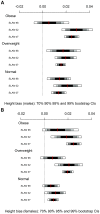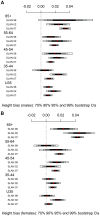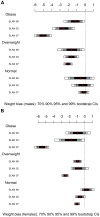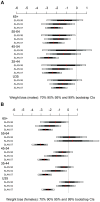Height and weight bias: the influence of time
- PMID: 23372717
- PMCID: PMC3553158
- DOI: 10.1371/journal.pone.0054386
Height and weight bias: the influence of time
Abstract
Background: We have previously identified in a study of both self-reported body mass index (BMI) and clinically measured BMI that the sensitivity score in the obese category has declined over a 10-year period. It is known that self-reported weight is significantly lower that measured weight and that self-reported height is significantly higher than measured height. The purpose of this study is to establish if self-reported height bias or weight bias, or both, is responsible for the declining sensitivity in the obese category between self-reported and clinically measured BMI.
Methods: We report on self-reported and clinically measured height and weight from three waves of the Surveys of Lifestyle Attitudes and Nutrition (SLÁN) involving a nationally representative sample of Irish adults. Data were available from 66 men and 142 women in 1998, 147 men and 184 women in 2002 and 909 men and 1128 women in 2007. Respondents were classified into BMI categories normal (<25 kg/m(2)), overweight (25-<30 kg/m(2)) and obese (≥30 kg/m(2)).
Results: Self-reported height bias has remained stable over time regardless of gender, age or clinical BMI category. Self-reported weight bias increases over time for both genders and in all age groups. The increased weight bias is most notable in the obese category.
Conclusions: BMI underestimation is increasing across time. Knowledge that the widening gap between self-reported BMI and measured BMI is attributable to an increased weight bias brings us one step closer to accurately estimating true obesity levels in the population using self-reported data.
Conflict of interest statement
Figures




Similar articles
-
Validity of Self-Reports of Height and Weight among the General Adult Population in Japan: Findings from National Household Surveys, 1986.PLoS One. 2016 Feb 10;11(2):e0148297. doi: 10.1371/journal.pone.0148297. eCollection 2016. PLoS One. 2016. PMID: 26862762 Free PMC article.
-
Temporal trends in misclassification patterns of measured and self-report based body mass index categories--findings from three population surveys in Ireland.BMC Public Health. 2010 Sep 17;10:560. doi: 10.1186/1471-2458-10-560. BMC Public Health. 2010. PMID: 20849632 Free PMC article.
-
Temporal changes in bias of body mass index scores based on self-reported height and weight.Int J Obes (Lond). 2013 Mar;37(3):461-7. doi: 10.1038/ijo.2012.67. Epub 2012 May 1. Int J Obes (Lond). 2013. PMID: 22546777 Free PMC article.
-
Challenging the role of social norms regarding body weight as an explanation for weight, height, and BMI misreporting biases: development and application of a new approach to examining misreporting and misclassification bias in surveys.BMC Public Health. 2011 May 18;11:331. doi: 10.1186/1471-2458-11-331. BMC Public Health. 2011. PMID: 21592341 Free PMC article.
-
[How accurate are self-reported anthropometrics among the Japanese? A scoping review].Nihon Koshu Eisei Zasshi. 2023 Dec 21;70(12):817-827. doi: 10.11236/jph.23-020. Epub 2023 Sep 5. Nihon Koshu Eisei Zasshi. 2023. PMID: 37673596 Japanese.
Cited by
-
Higher Pre-pregnancy BMI and Excessive Gestational Weight Gain are Risk Factors for Rapid Weight Gain in Infants.Matern Child Health J. 2017 Jun;21(6):1396-1407. doi: 10.1007/s10995-016-2246-z. Matern Child Health J. 2017. PMID: 28083729
-
Barriers and facilitators to initial and continued attendance at community-based lifestyle programmes among families of overweight and obese children: a systematic review.Obes Rev. 2017 Feb;18(2):183-194. doi: 10.1111/obr.12478. Epub 2016 Nov 10. Obes Rev. 2017. PMID: 27862851 Free PMC article.
-
Validity of Self-Reports of Height and Weight among the General Adult Population in Japan: Findings from National Household Surveys, 1986.PLoS One. 2016 Feb 10;11(2):e0148297. doi: 10.1371/journal.pone.0148297. eCollection 2016. PLoS One. 2016. PMID: 26862762 Free PMC article.
-
Height with Age Affects Body Mass Index (BMI) Assessment of Chronic Disease Risk.Nutrients. 2023 Nov 6;15(21):4694. doi: 10.3390/nu15214694. Nutrients. 2023. PMID: 37960347 Free PMC article.
-
"We only have the one": Mapping the prevalence of people with high body mass to aid regional emergency management planning in aotearoa New Zealand.Int J Disaster Risk Reduct. 2020 Dec;51:101859. doi: 10.1016/j.ijdrr.2020.101859. Epub 2020 Sep 12. Int J Disaster Risk Reduct. 2020. PMID: 32953440 Free PMC article.
References
-
- Faeh D, Marques-Vidal P, Chiolero A, Bopp M (2008) Obesity in Switzerland: do estimates depend on how body mass index has been assessed? Swiss Med Wkly 138: 204–210. - PubMed
-
- Niedhammer I, Bugel I, Bonenfant S, Goldberg M, Leclerc A (2000) Validity of self-reported weight and height in the French GAZEL cohort. International Journal of Obesity 24: 1111–1118. - PubMed
-
- Gorber SC, Tremblay M, Moher D, Gorber B (2007) A comparison of direct vs. self-report measures for assessing height, weight and body mass index: a systematic review. Obes Rev 8: 307–326. - PubMed
-
- Oliveira A, Ramos E, Lopes C, Barros H (2009) Self-reporting weight and height: misclassification effect on the risk estimates for aute myocardial infarction. European Journal of Public Health 19: 548–553. - PubMed
MeSH terms
LinkOut - more resources
Full Text Sources
Other Literature Sources
Medical
Miscellaneous

